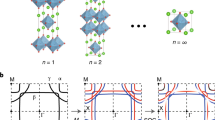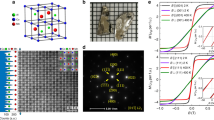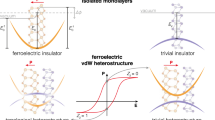Abstract
In ferromagnets, an electric current generally induces a transverse Hall voltage in proportion to the internal magnetization. This effect is frequently used for the electrical readout of the spin-↑ and spin-↓ states. Although these properties are usually not expected in antiferromagnets, recent theoretical studies predicted that a non-coplanar antiferromagnetic order with finite scalar spin chirality—meaning a solid angle spanned by neighbouring spins—can induce a large spontaneous Hall effect even without a net magnetization or external magnetic field. This phenomenon—the spontaneous topological Hall effect—can potentially be used for the efficient electrical readout of antiferromagnetic states, but it has not been experimentally verified due to a lack of appropriate materials hosting such magnetism. Here we report the discovery of an all-in–all-out-type non-coplanar antiferromagnetic order in triangular lattice compounds CoTa3S6 and CoNb3S6. These compounds are reported to host unconventionally large spontaneous Hall effects despite their vanishingly small net magnetization, and our analysis reveals that it can be explained in terms of the topological Hall effect that originates from the fictitious magnetic field associated with scalar spin chirality. These results indicate that the scalar spin chirality mechanism offers a promising route to the realization of a giant spontaneous Hall response even in compensated antiferromagnets, and highlight intercalated van der Waals magnets as a promising quasi-two-dimensional material platform to enable various non-trivial ways of electrical reading and the possible writing of non-coplanar antiferromagnetic domains.
This is a preview of subscription content, access via your institution
Access options
Access Nature and 54 other Nature Portfolio journals
Get Nature+, our best-value online-access subscription
$29.99 / 30 days
cancel any time
Subscribe to this journal
Receive 12 print issues and online access
$209.00 per year
only $17.42 per issue
Buy this article
- Purchase on Springer Link
- Instant access to full article PDF
Prices may be subject to local taxes which are calculated during checkout




Similar content being viewed by others
Data availability
The data presented in this paper are available from the corresponding authors on reasonable request.
References
Nagaosa, N. et al. Anomalous Hall effect. Rev. Mod. Phys. 82, 1539 (2010).
Chen, H. et al. Anomalous Hall effect arising from noncollinear antiferromagnetism. Phys. Rev. Lett. 112, 017205 (2014).
Nakatsuji, S. et al. Large anomalous Hall effect in a non-collinear antiferromagnet at room temperature. Nature 527, 212–215 (2015).
Nayak, A. et al. Large anomalous Hall effect driven by a nonvanishing Berry curvature in the noncolinear antiferromagnet Mn3Ge. Sci. Adv. 2, 1501870 (2016).
Kuroda, K. et al. Evidence for magnetic Weyl fermions in a correlated metal. Nat. Mater. 16, 1090–1095 (2017).
Higo, T. et al. Large magneto-optical Kerr effect and imaging of magnetic octupole domains in an antiferromagnetic metal. Nat. Photon. 12, 73–78 (2018).
Tsai, H. et al. Electrical manipulation of a topological antiferromagnetic state. Nature 580, 608–613 (2020).
Baltz, V. et al. Antiferromagnetic spintronics. Rev. Mod. Phys. 90, 015005 (2018).
Parkin, S. S. S. & Friend, R. H. 3d transition-metal intercalates of the niobium and tantalum dichalcogenides. I. Magnetic properties. Philos. Mag. B 41, 65–93 (1980).
Parkin, S. S. S. & Friend, R. H. 3d transition-metal intercalates of the niobium and tantalum dichalcogenides. II. Transport properties. Philos. Mag. B 41, 95–112 (1980).
Parkin, S. S. P., Marseglia, E. A. & Brown, P. J. Magnetic structure of Co1/3NbS2 and Co1/3TaS2. J. Phys. C: Solid State Phys. 16, 2765 (1983).
Ghimire, N. J. et al. Large anomalous Hall effect in the chiral-lattice antiferromagnet CoNb3S6. Nat. Commun. 9, 3280 (2018).
Park, P. et al. Field-tunable toroidal moment and anomalous Hall effect in noncollinear antiferromagnetic Weyl semimetal Co1/3TaS2. npg Quantum Mater. 7, 42 (2022).
Šmejkal, L. et al. Crystal time-reversal symmetry breaking and spontaneous Hall effect in collinear antiferromagnets. Sci. Adv. 6, 8809 (2020).
Park, H. et al. First-principles study of magnetic states and the anomalous Hall conductivity of MNb3S6 (M = Co, Fe, Mn, and Ni). Phys. Rev. Materials 6, 024201 (2022).
Shindou, R. & Nagaosa, N. Orbital ferromagnetism and anomalous Hall effect in antiferromagnets on the distorted fcc lattice. Phys. Rev. Lett. 87, 116801 (2001).
Martin, I. & Batista, C. D. Itinerant electron-driven chiral magnetic ordering and spontaneous quantum Hall effect in triangular lattice models. Phys. Rev. Lett. 101, 156402 (2008).
Akagi, Y. & Motome, Y. Spin chirality ordering and anomalous Hall effect in the ferromagnetic Kondo lattice model on a triangular lattice. J. Phys. Soc. Jpn 79, 083711 (2010).
Feng, W. et al. Topological magneto-optical effects and their quantization in noncoplanar antiferromagnets. Nat. Commun. 11, 118 (2020).
Taguchi, Y. et al. Spin chirality, Berry phase, and anomalous Hall effect in a frustrated ferromagnet. Science 291, 2573–2576 (2001).
Neubauer, A. et al. Topological Hall effect in the A phase of MnSi. Phys. Rev. Lett. 102, 186602 (2009).
Kurumaji, T. et al. Skyrmion lattice with a giant topological Hall effect in a frustrated triangular-lattice magnet. Science 365, 914–918 (2019).
Moon, R. M. et al. Polarization analysis of thermal-neutron scattering. Phys. Rev. 181, 920 (1969).
Yanagi, Y. et al. Generation of modulated magnetic structures based on cluster multipole expansion: application to α-Mn and CoM3S6. Phys. Rev. B 107, 014407 (2023).
Seemann, M. et al. Symmetry-imposed shape of linear response tensors. Phys. Rev. B 92, 155138 (2015).
Ueda, K. et al. Magnetic-field induced multiple topological phases in pyrochlore iridates with Mott criticality. Nat. Commun. 8, 15515 (2017).
Ueda, K. et al. Spontaneous Hall effect in the Weyl semimetal candidate of all-in all-out pyrochlore iridate. Nat. Commun. 9, 3032 (2018).
Akagi, Y., Udagawa, M. & Motome, Y. Hidden multiple-spin interactions as an origin of spin scalar chiral order in frustrated Kondo lattice models. Phys. Rev. Lett. 108, 096401 (2012).
Moriya, T. Anisotropic superexchange interaction and weak ferromagnetism. Phys. Rev. 120, 91 (1960).
Bazhan, A. N. & Bazan, C. H. Weak ferromagnetism in CoF2 and NiF2. JETP 42, 898 (1975).
Suzuki, M.-T. et al. Multipole expansion for magnetic structures: a generation scheme for a symmetry-adapted orthonormal basis set in the crystallographic point group. Phys. Rev. B 99, 174407 (2019).
Hirschberger, M. Topological Nernst effect of the two-dimensional skyrmion lattice. Phys. Rev. Lett. 125, 076602 (2020).
Nomoto, T. & Arita, R. Cluster multipole dynamics in noncollinear antiferromagnets. Phys. Rev. Research 2, 012045(R) (2020).
Tenasini, G. et al. Giant anomalous Hall effect in quasi-two-dimensional layered antiferromagnet Co1/3NbS2. Phys. Rev. Research 2, 023051 (2020).
Gong, C. & Zhang, X. Two-dimensional magnetic crystals and emergent heterostructure devices. Science 363, eaav4450 (2019).
Tokura, Y. & Nagaosa, N. Transverse spin forces and non-equilibrium particle dynamics in a circularly polarized vacuum optical trap. Nat. Commun. 9, 3704 (2018).
Takata, S. et al. The design and q resolution of the small and wide angle neutron scattering instrument (TAIKAN) in J-PARC. JPS Conf. Proc. 8, 036020 (2015).
Inamura, Y. et al. Development status of software ‘Utsusemi’ for chopper spectrometers at MLF, J-PARC. J. Phys. Soc. Jpn 82, SA031 (2013).
Ohhara, T. et al. SENJU: a new time-of-flight single-crystal neutron diffractometer at J-PARC. J. Appl. Cryst. 49, 120–127 (2016).
Ohhara, T. et al. Development of data processing software for a new TOF single crystal neutron diffractometer at J-PARC. Nucl. Instrum. Methods Phys. Res. A: Accel. Spectrom. Detect. Assoc. Equip. 600, 195–197 (2009).
Petricek, V., Dusek, M. & Palatinus, L. Crystallographic computing system JANA2006: general features. Z. Kristallogr. 229, 345–352 (2014).
Kresse, G. & Furthmüller, J. Efficiency of ab-initio total energy calculations for metals and semiconductors using a plane-wave basis set. Comput. Mater. Sci. 6, 15–50 (1996).
Kresse, G. & Furthmüller, J. Efficient iterative schemes for ab initio total-energy calculations using a plane-wave basis set. Phys. Rev. B 54, 11169 (1996).
Kresse, G. & Joubert, D. From ultrasoft pseudopotentials to the projector augmented-wave method. Phys. Rev. B 59, 1758 (1999).
Perdew, J. P., Ernzerhof, M. & Burke, K. Rationale for mixing exact exchange with density functional approximations. J. Chem. Phys. 105, 9982 (1996).
Monkhorst, H. J. & Pack, J. D. Special points for Brillouin-zone integrations. Phys. Rev. B 13, 5188 (1976).
Momma, K. & Izumi, F. VESTA 3 for three-dimensional visualization of crystal, volumetric and morphology data. J. Appl. Cryst. 44, 1272–1276 (2011).
Acknowledgements
We thank Y. Taguchi, T. Arima, S. Hayami, Y. Motome, N. Nagaosa and S. Maekawa for enlightening discussions and experimental help. This work was partly supported by Grants-In-Aid for Scientific Research (grant nos. 18H03685, 19H01856, 19H05825, 20H00349, 20H05262, 20K05299, 20K21067, 21H01789, 21H04437, 21H04440, 21H04990, 21K13873, 21K13876, 21K18595, 22H04965) from JSPS; PRESTO (grant nos. JPMJPR18L5, JPMJPR20B4, JPMJPR20L7) and CREST (grant no. JPMJCR1874) from JST; Katsu Research Encouragement Award; and UTEC-UTokyo FSI Research Grant Program of the University of Tokyo, Asahi Glass Foundation and Murata Science Foundation. The neutron scattering experiments at the Materials and Life Science Experimental Facility of the J-PARC and Japan Research Reactor 3 were performed under user programs (proposal nos. 2017L0701, 2020B0119, 21401, 21511 and 22529). The illustration of the crystal structure was drawn by VESTA47.
Author information
Authors and Affiliations
Contributions
S.S., H.T. and R.T. planned the project. H.T., R.T., N.D.K., K.K., Y.T. and S.S. prepared the samples and performed the macroscopic measurements. H.T., T. Nakajima, S.S., R.K., K.O., H.S. and D.H. performed the neutron and X-ray diffraction experiments. S.M., T. Nomoto, M.-T.S., Y.Y., M.H. and R.A. performed the theoretical calculations. S.S. and H.T. wrote the manuscript with support from T. Nakajima, S.M. and R.A. All the authors discussed the results and commented on the manuscript.
Corresponding author
Ethics declarations
Competing interests
The authors declare no competing interests.
Peer review
Peer review information
Nature Physics thanks Zurab Guguchia, Saül Vélez and the other, anonymous, reviewer(s) for their contribution to the peer review of this work.
Additional information
Publisher’s note Springer Nature remains neutral with regard to jurisdictional claims in published maps and institutional affiliations.
Supplementary information
Supplementary Information
Supplementary Figs. 1–11, Notes I–XI and Table 1.
Rights and permissions
Springer Nature or its licensor (e.g. a society or other partner) holds exclusive rights to this article under a publishing agreement with the author(s) or other rightsholder(s); author self-archiving of the accepted manuscript version of this article is solely governed by the terms of such publishing agreement and applicable law.
About this article
Cite this article
Takagi, H., Takagi, R., Minami, S. et al. Spontaneous topological Hall effect induced by non-coplanar antiferromagnetic order in intercalated van der Waals materials. Nat. Phys. 19, 961–968 (2023). https://doi.org/10.1038/s41567-023-02017-3
Received:
Accepted:
Published:
Issue Date:
DOI: https://doi.org/10.1038/s41567-023-02017-3
This article is cited by
-
Lattice-commensurate skyrmion texture in a centrosymmetric breathing kagome magnet
npj Quantum Materials (2024)



